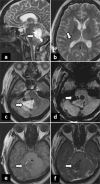High-grade astrocytoma with piloid features: A case report and review of literature
- PMID: 40041064
- PMCID: PMC11878694
- DOI: 10.25259/SNI_889_2024
High-grade astrocytoma with piloid features: A case report and review of literature
Abstract
Background: High-grade astrocytoma with piloid features (HGAP) is a rare, newly recognized brain tumor, typically seen in middle aged to elderly patients, often associated with neurofibromatosis type 1.
Case description: We report the first documented case of HGAP in Pakistan in a 57-year-old woman with tremors, vertigo, and cerebellar signs. Magnetic resonance imaging showed a cerebellar lesion, and after resection, initial pathology suggested a pilocytic astrocytoma. Molecular testing confirmed HGAP with a CDKN2A/B deletion. Despite treatment, including a second surgery, the disease progressed.
Conclusion: This case highlights the diagnostic challenges of HGAP and underscores the importance of advanced molecular testing for accurate diagnosis. Given the poor prognosis and limited treatment options, further research is needed to understand this rare tumor entity better and improve patient outcomes.
Keywords: Brain tumors; High-grade astrocytoma; High-grade astrocytoma with piloid features; Neurofibromatosis type 1; Piloid features; South Asia.
Copyright: © 2025 Surgical Neurology International.
Conflict of interest statement
There are no conflicts of interest.
Figures






References
-
- Cielo B. QLTI-01. High-grade astrocytoma with piloid features response to treatment with carboplatin and vincristine. Neuro Oncol. 2023;25(Suppl 5):v244–5.
Publication types
LinkOut - more resources
Full Text Sources
Research Materials
Miscellaneous
